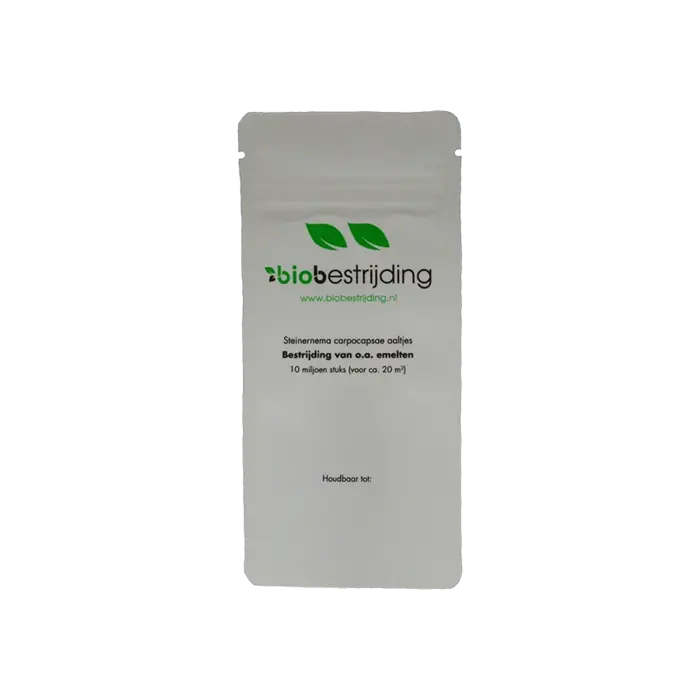BioBestrijding | Nematodes against Emelten ~ Steinernema Carpocapsae
BioBestrijding Nematodes against Leatherjackets
Attention! This product consists of live animals and is only available for order in the Netherlands or Belgium. If you order more than just Bio Fight, there will be an additional charge of € 7.95 due to dropshipping from the supplier.
The Steinernema carpocapsae nematodes can be used as biological control agents against the larvae of various pests. This nematode is particularly effective against crane flies (Tipulidae) on caterpillars (box moth, night owls, Opogena, codling moth, cabbage owl, vegetable owl and the moth Duponchelia fovealis), leatherjackets and larvae of overflies, larvae of the large pine beetle (Hylobius abietis), various other beetles (Coleoptera) and peat moles (Orthopthera). These nematodes also work against other insects such as ticks, fleas and copper worms. The Steinernema carpocapsae is a real glutton. They are supplied in mineral powder ready to be mixed with water. With this mixture you can easily spray the soil with a watering can.
Nematodes are effective against
The Steinernema carpocapsae nematodes are effective against the larvae and pupae of the following pests: Long-legged mosquitoes (Tipulidae), caterpillars (night owls, Opogena, codling moth, cabbage owl, vegetable owl, boxelder moth and Duponchelia fovealis), leatherjackets and larvae of overflies, larvae of the large pine beetle (Hylobius abietis), various other beetles (Coleoptera) and cranberry moths (Orthopthera). These nematodes also work against other insects such as ticks, fleas and copper worms.
What are Nematodes?
Nematodes are naturally occurring roundworms (Nematodes) found in the soil. They are very small (0.3 to 0.7 mm) and therefore invisible. They are harmless to humans, animals and plants.
How does the control with nematodes work?
Nematodes live in the soil and search for larvae and pupae of pests. They cannot control adults. There are many types of nematodes, each specifically targeting a particular type of host. They enter their prey and infect it with a bacterium from their intestinal tract. This bacterium multiplies inside the host and causes it to stop doing damage and eventually die. Nematodes then feed on these same bacteria which in turn causes them to multiply. A single insect larva can be the hotbed for as many as thousands of nematodes. The pest insects are thus besieged by a veritable army of nematodes. As soon as the host is killed, the nematodes leave it and go in search of new hosts. As long as prey is present in the soil the nematodes can sustain themselves and reproduce.
Temperature and environment
The nematodes can be introduced at a soil temperature between 4 and 34 degrees. It is important that the nematodes are applied to a moist soil that may not dry out for several weeks to have an optimal effect. Regular spraying in dry weather is therefore a must. During or just before a rainstorm is an ideal moment to introduce the nematodes. Note: do not introduce during night frost.
Deployment
When exactly to introduce the nematodes depends on the development stage of the host. Ideally, the host should be in a sensitive state so that the nematodes can easily penetrate the prey. Because nematodes only target the larvae and pupae of the pests, they are best released in late spring and early fall. We recommend around 500,000 nematodes per m2 for a light infection. In case of a larger infection you can increase this number to 1 million nematodes per m2. You can repeat this application after 2-3 weeks. The release in soil application goes as follows:
- Allow the nematodes to come to room temperature at least half an hour before deployment.
- Take a watering can with an opening of at least 0.5 mm.
- Remove any strainers or closures so the water comes out freely.
- Take a bucket and fill it with 5 to 10 liters of lukewarm water (15-20 degrees).
- Throw the whole pack of nematode powder into the bucket and stir it well so that no lumps are visible anymore.
- Then let the mixture soak for 5 minutes. After this stir well again.
- Advice is 500.000 nematodes per m2. You must dilute the mixture of 10 liters so that you spray the right number of nematodes per m2.
- Spray the mixture evenly over the soil. Remember to keep the soil well moist in the first 2 weeks.
- After the treatment, spray the soil well so that any above ground nematodes still have the opportunity to enter the soil.
Storage life
We recommend to use the nematodes as soon as possible after receipt. If you want to store them longer you can keep them in a refrigerator (2-8 degrees). On the packaging is the expiry date.
Please note! If you order more than just BioBestrijding, there will be € 7.95 extra charge because of the dropshipping from the supplier.





